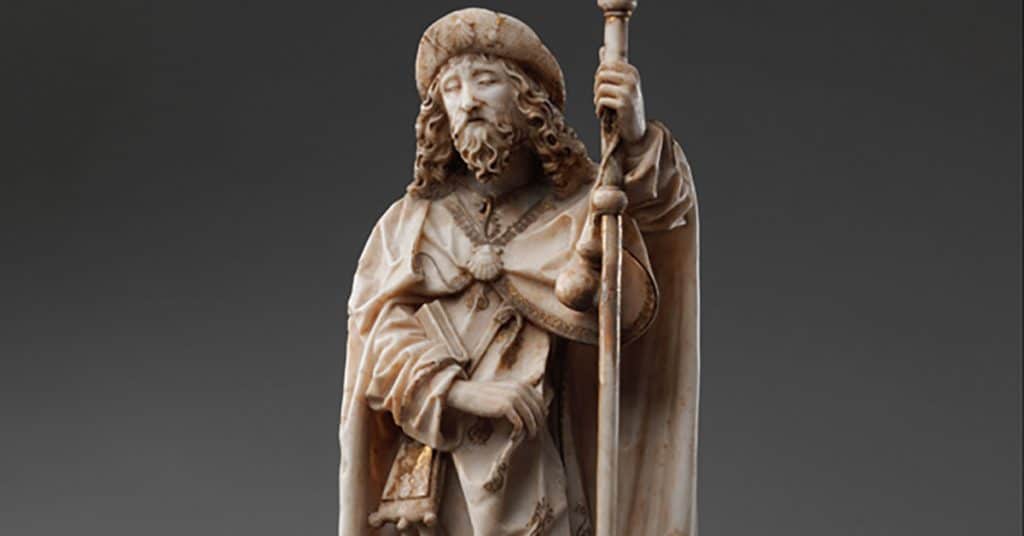St James the Greater was one of the Twelve Apostles of Jesus. His Catholic feast day is July 25. He is the patron saint of Spain and Guatemala. He is also the patron saint of Galicia, the nation-state in the northwest corner of Spain, and many small towns across the Latin world including Loíza, Puerto Rico which holds one of island’s most beautiful patron saint festivals.
St James
In this epoch when we are reexamining the meaning of icons of identity, Saint James is a complicated figure. The way some cultures use him to justify thievery and violence is sickening and not worthy of any saint.
In Spain, Saint James is an icon of the Reconquista, the Christian wars that pushed the Moors out of Spain and expelled the Jewish people. Basically, he is a potent national symbol who represents the wanton killing of people of color.
We think it is weird that we would celebrate someone who symbolizes killing us, but there may be some genius to it. Sometimes the best place to hide is in plain sight. Preserving your own forbidden traditions by hiding them inside the colonizer’s most revered traditions just may be brilliant. We’re not honoring our gods. We are honoring yours. LOL.
Who is Saint James?
James is a common biblical name and there are many variations of it in different languages. Santiago and even San Diego are variations.
There is another Apostle Saint James, the brother of Jesus, who is known as Saint James the Lesser to distinguish between the two.
Saint James the Greater was the son of Zebedee and the brother of John the Apostle. He was one of the first apostles of Jesus and was present at the Transfiguration.
Symbols of the Saint

Scallops are his primary symbol. He is usually depicted with a staff, cockleshell (scallop) and a man bag. You can see all three in the sculpture. Such shells are common on the Atlantic coast near the Spanish town of Santiago de Compostela.
The Cross of Saint James is a sword with a scallop as its handle.
The Met Cloisters in Fort Tryon Park in Washington Heights has several artworks that show Saint James in its collection.
Santiago de Compostela
Saint James the Greater had a bad temper. He was beheaded by the hand of Herod Agrippa, King of Judea and grandson of Herod the Great.
Saint James’ head is a relic of the 12th-century Armenian Cathedral of Saint James in Jerusalem. The Cathedral honors both Saint James.
According to legend, Saint James the Greater’s body miraculously washed ashore in Galicia, Spain. It was found and buried in the Cathedral of Santiago de Compostela. The story was recorded in the twelfth century.
The Way of Saint James
El Camino de Santiago was a pilgrimage route, or series of routes, in the Middle Ages from the Pyrenees across Northern Spain to the cathedral in Galicia. It has long been a perilous journey, and can still be dangerous today.
The ancient pilgrimage died out, but was repopularized by Walter Starkie’s book The Road to Santiago (1957).
The Original Way through Spain became a UNESCO World Heritage Site in 1993. The routes in France, the French Way, were added in 1998. There is also a Portuguese Way.
Santiago Matamoros is Complicated
The name means Saint James the Moor killer. It refers to a legendary Battle of Clavijo, a small town in La Rioja, Spain. According to legend, the long-dead Saint James suddenly appeared and helped an outnumbered Christian army defeat the Moors. Santiago Matamoros became an icon of the Reconquista, the reconquest of Muslim Spain, by Christian forces which began in Asturias, the nation-state to the east of Galicia.
Today, we should know better than to kill each other for religious reasons.
Fiesta de Santiago Apóstol in Loíza, Puerto Rico
Most towns with a Hispanic heritage have a patron saint.
Santiago Apóstol is the patron saint of Loíza, one of the most Afro-Puerto Rican towns. Loíza’s Fiesta de Santiago Apóstol has carnival parades and bands for about a month in July. It is one of the most beautiful patron saint festivals in Puerto Rico.
